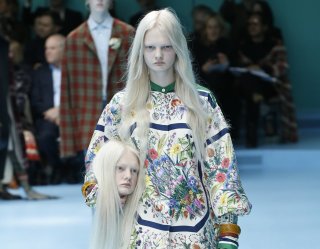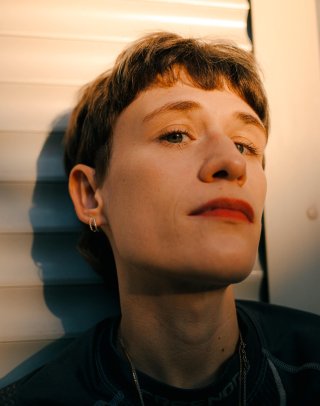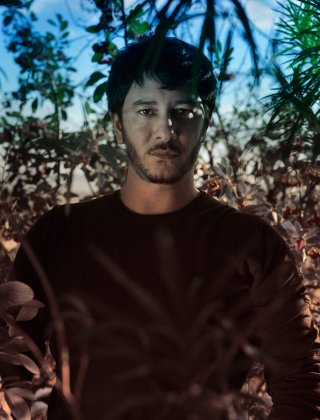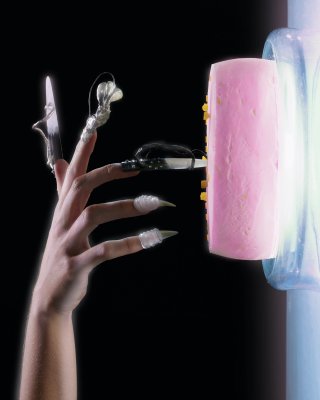Communicating Fashion Brands. Online-Talk mit Emily Huggard, Parsons School of Design, The New School
Wie kommunizieren Fashion Labels? Welche Methoden und Kommunikationstechniken wenden sie an? Und inwiefern hat dies gesellschaftliche und kulturelle Bedeutung?
8.03.2023, online
Über diese und weitere Fragen sprachen wir beim AFA Community Online-Talk mit Emily Huggard, Assistenzprofessorin für Modekommunikation an der Parsons School of Design, The New School in New York, und Autorin des Buches Communicating Fashion Brands: Theoretical and Practical Perspectives.
In ihrer Forschung untersucht Emily Huggard Markenerlebnisse in einer Epoche der digitalen Mode und des Postkonsums, sich wandelnde Ideologien des Luxus und Installationskunst als Instrument von Brand Experiences. Zusätzlich ist Emily Huggard als Brand Consultant tätig und entwickelt strategische Modekommunikation, Marketing- und Markenstrategien.

Interview
Please introduce yourself, who are you, where are you from, what do you do, what did you study?
I am an Assistant Professor of Fashion Communication at Parsons School of Design, The New School in New York. I am the regional editor for Bloomsbury Fashion Business Case Studies, and the editor of the book Communicating Fashion Brands: Theoretical and Practical Perspectives. My research focuses on fashion brand communication in the age of digital fashion and post-consumerism, how fashion brands communicate about sustainable practices, and the changing ideologies of luxury fashion brands. I also act as a consultant for brands in the designer fashion sector. I grew up in Canada and have a Business Commerce undergraduate degree (Canada), followed by an MA in Strategic Fashion Marketing from the London College of Fashion. I lived and worked in London for 9 years and now reside in Brooklyn New York.
How do fashion brands communicate? Are there any general systems or headlines you could name?
Brands communicate in many ways, just as humans do. If you personify a brand, they have a unique voice, a belief system, an aesthetic and a story to tell. Brands tell this story via diverse platforms, interfaces or platforms in ways that are relevant to their audience (tapped into cultures, subculture, art, music etc.).
Fashion brand communication encompasses visual brand communication (creative direction and styling, visual content creation for social media), product design, advertising, public relations, brand experience (physical and digital), sponsorship and collaboration, digital marketing and brand communication (organic and paid content), user-generated content, newsletter marketing, content marketing and influencer or KOL (key opinion leader) marketing.
Can you give some examples of different ways / possibilities to communicate within the fashion sector?
Brand communication is the process in which companies inform, persuade, enlighten, teach, remind, and enrich the knowledge of their audiences and stakeholders about the brand, its vision, values, products and services (Bhasin, 2018). Brand communication is a vital part of product development, pricing strategy, product retail/distribution and product promotion. Fashion brands are also tasked with being transparent about their environmental and supply chain impact based on facts and truth, to show their audiences how their values align with their own.
Brand communication strategy is developed using the marketing funnel, a visual representation of the journey a person takes from the moment they have any interaction with a brand—scrolling on Instagram for example—to the moment they make a purchase. So the brand will develop strategies and tactics in the top funnel which are focused on building brand equity and engagement such as fashion shows, retail experiences, brand events and activations, media activities and PR; middle funnel which is about nurturing relationships, generating leads and interest via methods such as newsletters, organic brand content, influencer marketing; to the bottom of the funnel which is purely sales driven (performance marketing) so paid advertising (PPC or pay per click), paid influencer strategies, affiliate marketing.
Which system / way applies to which brand and why?
Each brand should adopt methods to communicate based on how their audience/consumer interacts with the brand – where do they spend their time? How do they want to interact with brands? When do they want to be communicated to? When do they want to be sold to? Each brand will have a specific approach to the marketing funnel and will know what objective/goal they are trying to achieve at each level.
What are the tools and techniques fashion brands can use for their successful communication?
I have listed many above, but the best way to think about it is through the marketing funnel and based on core objectives the brand has created so tactics range from developing new campaigns (imagery), organic social media content and short video, working with influencers on content partnerships, collaborations, press activities and gifting, brand experiences.
And what is successful communication anyway? What is the relevance of followers, influencers, digital and print media? In a time of more or less “democratic” access to global fashion and fashion shows should a label select between channels of attention or address “the” media in general?
Successful communication is when you are offering something of value to your customer/community. This could have an education focus – educating consumers about circularity, supply chains, and how their decisions impact our planet, about materiality, products or process (Marine Serre’s regenerated material library is a great example), an escapism focus, bringing people into the world of the brand through imagery, interactive experiences and events or social media content or entertainment (TikTok, Instagram stories or live).
Successful communication is also based on how the brand defines success – which is based on what they are measuring or their KPIs (key performance indicators). The brand will have business goals (such as sales, awareness, building loyalty and equity) and brand communication objectives will be built from business goals. Channels and strategies are then chosen based on the brand’s communication goals.
In your book you claim that the way fashion brands communicate is significant within wider society and can be perceived as culturally meaningful. Could you please explain this and give some examples?
Brands are sociocultural or cultural sources similar to film, advertising, social media and they act as vehicles for the ‘naturalizing’ or ‘normalizing’ of ideologies. This provides an opportunity to create new ideologies that favor equity, inclusion and social justice. GANNI is a good example of a brand communicating about sustainability in a way that feels relevant and simple to digest for the consumer. For example, they have various initiatives such as GANNI Repeat offering circular ways of ownership through reselling, rental (including a collaboration with Levi’s that was rental only), recycling and offering customers the opportunity to repair new and pre-loved GANNI clothes, a service to repair existing items. They also develop innovative materials that move towards greater circularity in fashion, collaborating with material science brands such as Vegea, a material using left-over grape skins from winemaking. They communicate these initiatives in a visual way on their website as well as a dedicated Instagram account @Ganni.Lab. They have also launched collaborations with brands such as 11 Honoré and Juicy Couture in extended sizing, creating imagery that represents and celebrates larger bodies. They use language that destigmatizes size “an honest approach to dressing, celebrating contrast, community and authenticity. It’s dressing for yourself and no-one else.“
What would you advise upcoming fashion labels for their brand communication? How can they create their world and storytelling and achieve medial presence even without a lot of financial means?
They should start with visual channels and their website (or other sales channels such as Instagram) that will tell your story. Their site should have a clear overview of who they are as a designer, their product, their values, strong imagery that brings the brand’s world to life. You can use found (and credited) imagery that illustrates what the brand is into or create behind the scenes stop-motion films of your making and process. They may also want to be part of a tradeshow or work with a showroom in a market they want to build the brand in. In many cases this is much more economically viable for new designers vs showing on a runway. If they want to secure funding through fundraising and investment you need to show that you have had sales of your product, how you see the brand growing and scaling.
They should also decide if they want to start with direct to consumer or secure wholesale/retail partners. Retail partners are now part of a brand’s marketing strategy as they will be able to tell the upcoming brand’s story and they already have an established customer base.
The brand should ask why someone would buy directly from them and is that clearly communicated?
And how is it possible to understand a label´s audience without having studied psychology or brand strategy?
Any brand large or small now has access to a huge amount of data. Once a website is built they can start using Google Analytics for enhanced ecommerce and shopping behavior, as well as social analytics to get an understanding of their consumer. If it is an emerging brand, they can also do qualitative research by talking to their consumers in focus groups or surveys through direct messages on Instagram or other.
What is most important for a) building a brand and b) being featured in the media?
Having a clear vision about why your brand exists in the world and what your unique perspective is. There are way too many clothes in the world, products that exist, what is the brand outside of their product, do they have a richer story outside of their pieces/collection, a point of view, a world people want to be a part of.
Are there any essentials for fashion labels to provide to the media that you could name? What are absolute musts and no-gos?
To secure media coverage, brands should have a website that clearly communicates the brand’s aestethic and value with an intuitive user flow, user friendly e-commerce, a look book and flat imagery on white background (for digital press). Start-up designers may want to work with a PR agency on a retainer who will have the media contacts and relationships to secure media coverage.
How does the future of fashion communication look like?
Brands will need to increase transparency in their supply chain as consumers are beginning to value sustainability over price. Sustainability is no longer a marketing strategy and brands need to speak about the sustainability of their product, how they engage in circularity, their values and how they plan to not only mitigate but repair the planet (climate positive). The rise of digital fashion, the metaverse and Web 3.0 also provide unique ways for consumers to interact with brands from buying wearables for digital gaming avatars, to wearing a digital dress on social media, to investing in non-fungible tokens (NFTs). Brands will continue to use web 3.0 to build community and further co-creation with the consumer (for product and marketing).
Which brand communication strategy / storytelling is your favorite at the moment? Why?
Storytelling that is not solely based on securing sales or pushing product – brands that want to educate their audiences and provide value to their lives. The brand Mara Hoffman is great at storytelling. They maintain an open conversation about their approach to sustainability and encourage their audiences/consumers to reevaluate the relationship society has with clothing. They have launched various initiatives to tell this story including the Climate Beneficial Capsule collection made entirely in the USA with regenerative wool (working with regenerative farms). They also launched a limited-edition capsule collection of past collection pieces (excess inventory), reinvented through garment and botanical dyes, finding new ways to engage and excite consumers about sustainable choices. They lengthen the lifespan of their garments through their Full Circle Marketplace, a platform for customers to buy and sell their pre-owned Mara Hoffman garments.
Mehr


